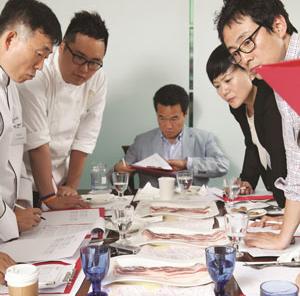 By U.S. Meat Export Federation
By U.S. Meat Export Federation
For the second time in two years, South Korea’s top cooking magazine, Cookand, joined with the U.S. Meat Export Federation (USMEF) for a blind taste test conducted with panels of food industry experts and consumers to determine which pork would be preferred by Koreans when taste is the only consideration.
Four types of chilled pork belly and collar butt (U.S., Canadian and two South Korean brands: Sunjin and Moguchon) were included in the sampling. To remove any favorable conditions for one type of pork over another, each sample was 10 days old, purchased from the sale seller, cut to the same portion size and cooked identically without seasoning.
Each participant judged the samples on tenderness, tastiness and juiciness, as well as how the pork smelled and its texture after cooking.
U.S. pork was the clear winner among the food industry experts on the panel, earning a score of 79 out of 100 versus 74 for Canadian pork and 74 and 69 for the two Korean pork brands. The consumer panel put U.S. and Canadian pork in a tie with a score of 74 while the two Korean pork brands earned scores of 62 and 53.
“I favored domestic pork prior to this test, but my preference has changed since the blind test,” said Lee Wook-Jung, producer for KBS television and graduate of Le Cordon Bleu, a world-renowned network of culinary schools. “The tenderness and taste of imported pork was as good as, if not better than, that of Korean pork.”
Cookand magazine assembled an impressive set of judges for the competition. A panel of 10 experts included a food reporter for daily newspaper Hankyoreh; the television producer/Le Cordon Bleu graduate; a food reporter for JoongAng Ilbo, Korea’s top daily newspaper; the owner of Tavern 38, a French-American bistro; the owner-chef of Korean restaurant Doodukhan Sang; the head chef at Oakwood Hotels; a food critic for JoongAng Ilbo; a cooking instructor and food researcher; a meat wholesaler; and a traditional cookery professor at Baewha Women’s University.
The food industry experts were joined by a panel of 10 consumers, four men and six women, including an international lawyer, chef, landscaper, financier, advertising agent, several food bloggers and several students studying to be nutritionists and food stylists.
Interestingly, the results of the Cookand test come on the heels of a recent survey by the Korea Rural Economic Institute (KREI), which questioned 750 consumers about their pork preferences. In that survey, 66.1 percent said they believe the quality of domestic pork is better while just under 1 percent said they prefer imported pork. The balance couldn’t tell the difference.
One of the Cookand survey participants noted the consideration of country of origin in his (her?) statement: “After the country of origin was revealed, I saw that I had given the highest score to U.S. pork,” said Jung Hye-Jung, head of the Creative Culinary Institute of Korea. “Because U.S. pork appeals with good price and quality, my preference didn’t change even after the place of origin was revealed. This experience helped me get rid of any prejudices against (U.S.) pork.”
“We worked with Cookand because it is the leading Korean cooking magazine, and we wanted to make sure the blind taste test was done with complete transparency,” said Jihae Yang, USMEF-Korea director. “We were very confident of the quality and taste of U.S. pork going into the competition, and we will use these results with meat distributors and end-users so they are aware of how well U.S. pork was judged by these experts.”
The test results were published in Cookand, as they were after the 2010 blind taste test. In the first competition, Cookand editors also selected collar butt and single-ribbed belly, which are the most popular pork cuts among Korean consumers. That contest compared frozen meat samples from Austria, Belgium, Chile and the United States and chilled meat samples from the U.S. against two domestic brands.
After the 2010 results were in, Cookand editors admitted their surprise at the outcome. “Beyond our expectations, U.S. pork was rated highly in both the frozen and chilled categories,” wrote the editors.
The preference for home-grown product was evident in the 2010 test.
“What is interesting was the evaluation on personal liking, which was different before and after disclosing the countries of origin,” the editors wrote. “In the case of chilled pork, U.S. pork scored high before disclosing the countries of origin. However, once the countries of origin and prices were revealed, domestic branded pork also scored high. These findings show that the professionals have some degree of emotional preference for domestic brands.”
South Korea is the No. 5 market for U.S. pork exports through the first four months of 2012, accounting for 67,061 metric tons (147.8 million pounds) valued at $192.7 million. Those totals are down from 2011 as Korea rebounds from an FMD outbreak that devastated the nation’s pork industry last year. However, the March 15 implementation of the Korea-U.S. Free Trade Agreement will help U.S. exports as it brings about the eventual elimination of all tariffs on U.S. pork imports.
Disclaimer: Articles featured on Oregon Report are the creation, responsibility and opinion of the authoring individual or organization which is featured at the top of every article.


